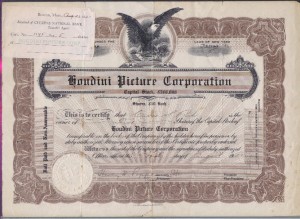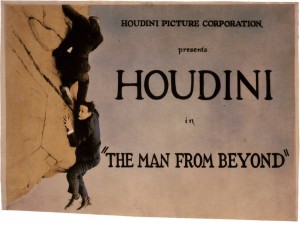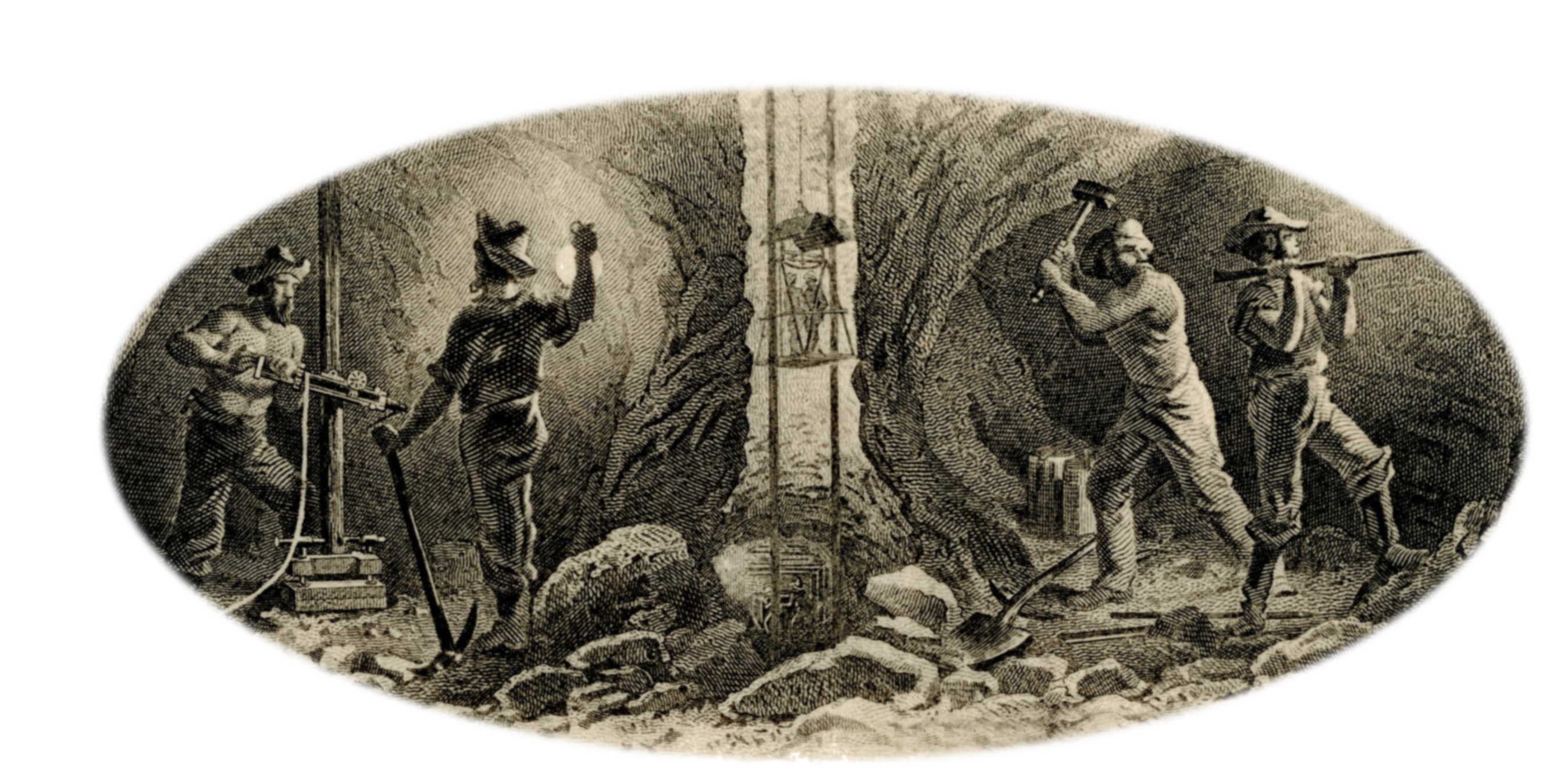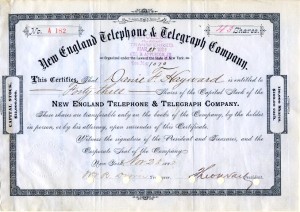STOCKS OF AMERICA’S PIONEERING TELECOMMUNICATIONS
See some our Facebook activity below:
[custom-facebook-feed]
Houdini Picture Corporation
By Fred Fuld III at AntiqueStocks.com
Author of the book: Let Me Entertain You with Antique Stock Certificates

If you ask the average person on the street to name one magician, chances are that the most popular response is Houdini. Harry Houdini, who was born Erik Weisz, (his family later changed it to Ehrich Weiss), was from Budapest but moved to the United States when he was four years old, first to Wisconsin, then to New York City.
He eventually became one of the world’s most famous, if not the most famous, magician, escape artist, and illusionist, taking on the name Harry Houdini. However, what many people don’t know about Houdini is that he was also a motion picture producer, director, actor, screenwriter, and stuntman. His company was called the Houdini Picture Corporation. (See the image above.)
What is unusual about several of these certificates that have appeared in the collectors’ market is that Houdini’s signature is very light. This has led many to speculate that Houdini was using disappearing ink.
So what did this company actually do? It produced three silent black and white movies from 1921 to 1923:
The Soul of Bronze
The Man From Beyond
Haldane of the Secret Service
The Soul of Bronze was actually a movie from France that Houdini reformatted and distributed, but did not star in. The Man From Beyond is a movie about a man (played by Houdini) who comes back to life after being frozen for 100 years in the arctic. Haldane (also played by Houdini of course) is about a Secret Service agent who goes after counterfeiters and tries to rescue a woman.

Not many people are aware that although Houdini was the president of the company, his brother Theodore Hardeen actually ran it. One of the investors in the company was Harry Keller, a popular magician in the late 1800’s and early 1900’s.
Houdini even appeared in a few other movies that he did not produce, including The Grim Game and Terror Island, both distributed by Paramount Pictures.
Houdini’s signature appears on one other stock certificate, Martinka & Company, the oldest magic company in the United States. The Society of American Magicians held their meetings in the back of the shop. Houdini was the owner in 1919. He used his formal signature to sign the certificates.
Originally Published and Printed by G.Labarre, The LaBarre Newsletter, Issue 1, Winter 1981
Historical Notes
Stock and bond certificates and shares are more than mere representations of wealth or financial gain. More than that, they are reflections of human endeavor, industrial expansion and the growth of this nation. Each has its own unique and fascinating story to tell. With those important points in mind, it is both interesting and useful for collectors and investors to be aware of historical background of companies that have issued stocks or bonds to finance their development and growth. This first issue of the “Stock and Bond Investment Quarterly” will discuss a perennial favorite of many types of collectors; railroad companies.
Taunton Branch Railroad Company, Massachusetts
This company was incorporated in April 1835, to construct a railroad from Taunton to Mansfield on the Boston and Providence line. Construction began that year, and was completed in August 1836. On July 2, 1840, the New Bedford and Taunton Railroad was completed, and connected with the Taunton Branch. Both railroads operated under the same management.
The original issue of capital stock amounted to $250,000 for the Taunton Branch. Actual construction costs overran that amount slightly at about $256,000. The line was short, running just over eleven miles. The railroad began paying dividends three years after completion, and within six years was paying a tidy six percent return on investment, a rate it was able to maintain for a number of years.
Attica & Allegheny Railroad Company, New York
The Attica & Allegheny Valley Railroad was succeeded by the Arcade & Attica Railroad.
Unlike the Taunton Branch Railroad Company already discussed, this railroad seemed doomed from the outset. Incorporated in November 1852, only about twenty-five miles of track were graded between Attica and Arcade during 1853 and 1854. In February 1856, the railroad was sold upon foreclosure of its mortgage.
Fall River Railroad Company, Massachusetts
This particular railroad was formed by the consolidation of three separate lines: the Fall River Branch, the Middleboro, and the Randolph and Bridgewater Companies. The Fall River Branch was incorporated in March 1844, to construct a line from Fall River to Myrick’s Station. Both the Middleboro and the Randolph and Bridgewater Companies were formed in March 1845, the former to construct a railroad from Bridgewater to the Fall River Branch at Myrick’s Station, and the latter to build a line from Bridgewater to the Old Colony Railroad in Braintree. The three merged in August 1845, following the successful completion of their respective segments of the entire line. In April of the following year, the merger was granted official sanction by an act passed by the state legislature.
Share capital of the three companies totaled slightly over $1,000,000, a significant investment for that era. Construction of the entire line to its junction with the Old Colony was completed in December 1846. The entire line covered forty-two miles. Nearly a decade later in 1854, the Fall River and Old Colony Lines were consolidated, thus forming the Old Colony and Fall River Railroad.
Old Colony and Fall River Railroad, Massachusetts
This merger was authorized on March 25, 1854. The total length of road operated by the company totaled about ninety miles.
One individual, Richard Borden, played an important role in the development of the Fall River Railroad and also the subsequent merger with the Old Colony. Born in 1795 in Fall River, Borden was one of the early industrialists of the area. Following the War of 1812, Borden became involved in shipbuilding, cotton milling, and ironworking, lucrative businesses, which expanded rapidly throughout the 1820’s and 1830’s. The Fall River Iron Works, in which he held a major interest, was created in 1821 with an initial capital investment of $18,000. By 1845, the business was worth almost one million dollars, and boasted an ironworks valued at half a million dollars.
Rapid, cheap transportation of materials and finished goods was naturally a source of considerable interest and concern to Borden. To that end, and mainly through his personal efforts and financial backing, the Fall River Railroad Company began construction in 1844, and was completed the following year. With the creation of the Fall River and Old Colony Railroad in 1854, yet another venture which was due in large part to Borden’s backing, the Fall River area (and Borden) achieved an important goal – a direct rail line to Boston. Not surprisingly, Borden served on the new line’s board of directors for several years during the 1850’s.
Stockbridge and Pittsfield Railroad, Massachusetts
Chartered in 1847, construction began in 1848, and the entire twenty-two miles of track running from Great Barrington to Pittsfield opened on January lst, 1850. The Housatonic Company took a perpetual lease of the railroad in the same month in exchange for a seven percent rent based upon the total construction cost of about $450.000. The Housatonic Company operated the line successfully for a number of years, consistently meeting its annual rent charge without difficulty.


New England Telephone & Telegraph Company signed by Theodore Vail (First President of AT&T) – New York 1883
Alexander Graham Bell invented the telephone and Theodore Vail invented the telephone business.
Fairfax, Virginia March 29, 2016
Scripophily.com is offering historic stock certificates from the New England Telephone & Telegraph Company which are hand signed by Theodore Vail issued in 1883. This early Bell Operating Company stock certificate has an ornate border around it with the company’s name on top center. This item has the signatures of the company’s president, Theodore Vail and treasurer, William R. Driver. This is the first telephone company certificate we have seen hand signed by Theodore Vail.
New England Telephone & Telegraph Company was chartered on October 19,1883 under the laws of New York State. The company was a merger of the Telephone Dispatch Company, the National Bell Telephone Company of Maine, the Boston and Northern Telephone Company, The Granite State Telephone Company and the Bay State and Suburban Telephone Company. The New England Telephone and Telegraph Company was a subsidiary of the original AT&T Company for seven decades.
Theodore Newton Vail (July 16, 1845 – April 16, 1920) was a U.S. telephone industrialist. Born in Minerva, Ohio, he served as the president of American Telephone & Telegraph (AT&T) between 1885 and 1889, and again from 1907 to 1919. He convinced President Woodrow Wilson that the telephone as a medium of communication would spread more rapidly if it was brought under one monopoly so as to ensure uniform provision of services throughout the country. He called this “one system, one policy, universal service”.
Theodore Vail was one of AT&T’s most far-sighted presidents. He oversaw the building of the first American coast to coast telephone system, and it was his dedication to basic science that initiated a new research arm for AT&T called Bell Laboratories. During his tenure, he set up the Western Electric Company, a division of the company which built telephone equipment.
Vail built the first long distance system, from Boston, Massachusetts to Providence, Rhode Island in 1881. In 1914, the first transcontinental line across the US became operational by AT&T and Vail made the first phone call from New York to San Francisco and a year later phone service was available to Europe.
Scripophily (scrip-ah-fil-ly) is the name of the hobby of collecting old stock and bond certificates. Certificate values range from a few dollars to more than $500,000 for the most unique and rare items. Tens of thousands of Scripophily buyers worldwide include casual collectors, corporate archives, business executives, museums and serious collectors. Due to the computer age, more and more stock and bonds are issued electronically which means fewer paper certificates are being issued. As a result, demand for paper certificates is increasing while supply is decreasing.
Scripophily.com – The Gift of History is the Internet’s leading buyer and seller of collectible stock and bond certificates and have items on loan for display in the Smithsonian’s Museum of Financial History in New York. Our company has been featured on CNBC, USA Today, Associated Press, Reuters, Nightline, Today Show, Baltimore Sun, and Washington Post and in many other media publications. The company also offers the World’s #1 old stock research service at OldCompany.com and offers high resolution scans for publications. Scripophily.com has over 17,500 selections on its website.
Scripophily.com / Old Company Research Service, founding member of the Old Stock Exchange, is the successor company to all material published by the Marvyn Scudders Manuals, the Robert D. Fisher Manuals, R.M. Smythe Stock Research Service, and the Herzog & Co., Inc. obsolete research services. These services have been performed continuously for over 136 years since 1880.
Scripophily.com and Old Company Research Services was founded by Bob Kerstein (Bob.com). Bob is a CPA and CGMA, and has more than 39 years of senior management experience in the Cellular, Cable TV, Satellite, Internet, Professional Sports and Entertainment Industries. Bob is also the President of the Professional Scripophily Traders Association (PSTA) and co founder of the American Stock and Bond Collectors Association.
For more information on Scripophily.com®, visit http://www.scripophily.com, http://www.oldcompany.com, http://www.scripophily.net, http://www.rambo.com, http://www.bob.com or call 1-703-787-3552.
For the original version on PRWeb visit: http://www.prweb.com/releases/2016/03/prweb13295643.htm
The American Stock and Bond Collectors Association (ASBCA) is a non-profit organization dedicated to furthering the education and study of American historical securities. Founding Directors Bob Kerstein and Scott Winslow are pleased to announce the launch of the association website (scripophilyusa.org) devoted to the interests of collecting old stock certificates and bonds. “We have developed what we hope to be the destination site for people seeking out information on Scripophily, as the field is known” says Winslow. “We intend to foster an environment of confidence and excitement in the future growth of this wonderful and important part of the history of entrepreneurship” adds Kerstein.
Scripophily [scrip-ah-fil-ly] is the hobby’s name of collecting old stock and bond certificates. Historical certificates which otherwise have no value as financial claims, are bought for their artistic and historical value by collectors. Values range from a few dollars to more than $100,000 for the rarest. Tens of thousands of Scripophily buyers worldwide include individuals decorating their home, corporate gift buyers, and casual and serious collectors.
Those visiting the Association’s website will find much useful information on the history and collecting of stocks and bonds. Information on pricing, grading and where to get in touch with industry leading professionals will be of great assistance to new collectors as well as those who may have certificates to sell. “It is our intention to provide a platform for easy access to shared information for those wishing to become more knowledgeable in the field of Scripophily” says Winslow.
“We want to establish meaningful historical price guides, rating and scarcity standards, so buyers of Scripophily can make a more educated decision before making a purchase” Kerstein notes. Both Winslow and Kerstein are decidedly optimistic that this organization will fill the information gap that has developed as the hobby has grown through the years.
Bob Kerstein is the founder of Scripophily.com and Old Company Research Service. He is a CPA and CGMA, and has more than 39 years of senior financial management experience in the Cellular, Cable TV, Satellite, Internet, Professional Sports and Entertainment Industries. Bob is also the President of the Professional Scripophily Traders Association (PSTA) and now spends all of his time in the field of Scripophily.
Scott Winslow, president of Scott J. Winslow Associates, Inc. is a member of all the major trade organizations, including the Manuscript Society, and the prestigious Professional Autograph Dealers Association. Mr. Winslow has been involved in the paper collectibles business for over thirty years. He has given numerous talks to various groups on paper collectibles and been consulted in the identification of forged securities and historical materials.
For more information on the The American Stock and Bond Collectors Association please go to scripophilyusa.org, call Bob Kerstein at 1-703-787-3552 or Scott Winslow at 603-641-8292.

Dear John:
Dear John: I found stock certificates for Playboy in a box in my closet. I took them to ScottTrade to sell, but they said they couldn’t help me.
I have been trying to track this down on my own, but got nowhere. Maybe you can point me in the right direction. I know it’s not much money, but it’s mine. B.V.
Dear B.V.: Playboy was taken private in 2011, and shareholders were paid $6.15 a share. You have one certificate for seven Class A shares and another for 21 Class B shares. So, in all, that would have been worth $172.20.
You can still cash these in by contacting Playboy’s transfer agent at the time, American Stock Transfer Co. in Brooklyn. The phone number is (888) 328-5369. There are some forms you will have to fill out.
But there is a lot more to the story about Playboy’s stock.
The certificates you showed me have a picture of a woman in flowing robes holding the globe. There’s a composite of various cities in the background.
These old certificates could possibly fetch $60 from collectors, according to Bob Kerstein, founder and chief executive of Scripophily.com, which deals in collectibles.
 But that’s not the most interesting part of this story.
But that’s not the most interesting part of this story.
Before the ones you own were issued, Playboy certificates had the image of a naked woman at the top — the February 1971 Playmate named Willy Rey (real name: Wilhelmina Rietveld), who posed for the image when Playboy went public that year.
 Those certificates, says Kerstein, are worth between $125 and $150 if they are in gold, and between $150 and $200 if they are blue.
Those certificates, says Kerstein, are worth between $125 and $150 if they are in gold, and between $150 and $200 if they are blue.
Tragically, Willy Rey died of an overdose of sleeping pills in 1973 when she was 23 years old.
Her image stayed on the Playboy stock certificates until 1990, when the company recapitalized.
Why did Rey’s image get the boot? “The stock certificate quickly became a novelty, and at one point there were about 14,000 single shareholders,” making it costly for the company to keep issuing so many single shares, a Playboy spokesperson told me.
Dear Readers,
Your letters to John Crudele are streaming in fast and furiously, asking Dear John to right the wrongs you’re facing. Because of this influx, The Post Business section will feature more of your inquiries in the hope of helping you with your troubles.
Send your questions to Dear John, The New York Post, 1211 Ave. of the Americas, NY, NY 10036, or john.crudele@nypost.com